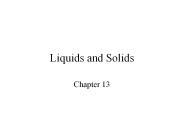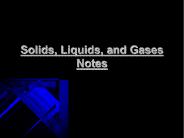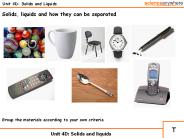Liquide Solid PowerPoint PPT Presentations
All Time
Recommended
CHAPTER 2 SOLIDS, LIQUIDS, & GASES I. States of Matter - A. Solids - have definite volume & definite shape In a solid, the molecules are tightly bound together ...
| PowerPoint PPT presentation | free to view
Chapter 10 Liquids and Solids Van Der Waals Forces These are intermolecular forces of attraction between neutral molecules. The Nobel Prize in Physics 1910 (Johannes ...
| PowerPoint PPT presentation | free to download
Solids and Liquids Chapters 16 and 17 Phase Changes Phase changes are due to changes in temperature, which affects kinetic energy, or pressure, which establishes how ...
| PowerPoint PPT presentation | free to view
Solids and Liquids AP Chemistry Chapter 11
| PowerPoint PPT presentation | free to view
Solids, Liquids, Gases Everything around us is made up of atoms. These tiny, little particles of matter which, with other atoms either the same or different types ...
| PowerPoint PPT presentation | free to view
Liquids and Solids Gas low density high compressibility completely fills its container Solid high density only slightly compressible rigid maintains its shape
| PowerPoint PPT presentation | free to view
Gas. Liquid. Solid. Highly Compressible. Slightly Compressible. Very slightly compressible. Low Density. High Density. High Density. Fills container completely
| PowerPoint PPT presentation | free to download
Covalent network solids such as quartz where atoms are held together by 3-D networks of covalent bonds. Here the hexagonal pattern of Si (violet) and O (red) atoms in ...
| PowerPoint PPT presentation | free to download
Covalent network solids such as quartz where atoms are held together by 3-D networks of covalent bonds. Here the hexagonal pattern of Si (violet) and O (red) atoms in ...
| PowerPoint PPT presentation | free to download
Title: Chapter 9 Subject: Intermolecular Forces in Liquids Author: Patricia Todebush Last modified by: ptodebus Created Date: 5/28/1995 5:04:24 PM Document ...
| PowerPoint PPT presentation | free to view
Liquids and Solids Chapter 14 14.1 ... The vapor pressure of the water must = the atmospheric pressure before boiling. 14.5 Boiling Point and Vapor Pressure What ...
| PowerPoint PPT presentation | free to download
Liquids and Solids Chapter 13 Solids, Liquids, and Gases Solids & liquids are condensed states atoms, ions, molecules are close to one another highly incompressible ...
| PowerPoint PPT presentation | free to download
Title: Liquids and Solids Author: csk19240 Last modified by: install Created Date: 2/25/2005 9:19:00 PM Document presentation format: On-screen Show (4:3)
| PowerPoint PPT presentation | free to download
Unit 5 Solids, Liquids & Solution Chemistry
| PowerPoint PPT presentation | free to download
Gases, Liquids and Solids States of Matter, Chapter 10 Objectives Describe the motion of gas particles according to the kinetic theory Interpret gas pressure in terms ...
| PowerPoint PPT presentation | free to view
Chapter 13 States of Matter SOLIDS, LIQUIDS AND GASSES ...
| PowerPoint PPT presentation | free to view
Solids, Liquids, and Gases Kinetic Theory The kinetic theory is an explanation of how particles in matter behave. The three assumptions of the kinetic theory are as ...
| PowerPoint PPT presentation | free to view
Solids, Liquids, and Gases Notes on 3.1 Describing states of matter Solid Liquid Gas Kinetic Theory Motion in gases The Kinetic Theory of Gases Three Main Points to ...
| PowerPoint PPT presentation | free to view
Forces at work (not chemical bonds) between molecules in liquids, ... Krypton- Atomic solid w/ nonpolar cov. Properties (LDF) Structure & Bonding in metals ...
| PowerPoint PPT presentation | free to view
Solids, Liquids and Gases March 2006 By the end of this lesson you will know: what a material is what we mean by property what the properties of solids ...
| PowerPoint PPT presentation | free to download
Materials exist as solids, liquids, and gases and sometimes as a ... Liquids: water, Coke, cooking oil, vinegar, gasoline, milk, honey, syrup, Mountain Dew ...
| PowerPoint PPT presentation | free to view
Solids, Liquids, Gases (and Solutions) Bonding in Solids Classification of Matter Solutions are homogeneous mixtures Solute A solute is the dissolved substance in a ...
| PowerPoint PPT presentation | free to view
Chapter 09 Liquids and Solids
| PowerPoint PPT presentation | free to view
Chapter 12 Liquids and Solids 2006, Prentice Hall
| PowerPoint PPT presentation | free to view
Liquids and Solids * * * * * * * * * * * * * * * * Crystalline Solids Covalent Network: Diamond Covalent Network: Graphite CHANGES IN STATE P 1 atm O T, in C ...
| PowerPoint PPT presentation | free to view
Solids sublime below triple point ... A solid can only sublime at temperatures below the triple point ... can be made to sublime by reducing the pressure of ...
| PowerPoint PPT presentation | free to view
to the molecules being close together in solids and liquids. and far ... The 1s, 2s, and 2p electrons are close to nucleus, so they are not able to move around. ...
| PowerPoint PPT presentation | free to view
Solids, Liquids, and Gases Notes I. ... Covalent, ionic, and metallic bonding are intramolecular forces. Metallic bonding is the strongest of the three.
| PowerPoint PPT presentation | free to download
Things that hold their shape are called solids. What is a liquid? ... Good for you! Try the next one... Try again! Which one is the gas? Try again! TERRIFIC JOB! ...
| PowerPoint PPT presentation | free to view
Chemistry B11 Chapter 5 Gases, Liquids, and Solids Gases T move faster Kinetic energy Gases Attractive forces Kinetic energy Keeps molecules apart Brings ...
| PowerPoint PPT presentation | free to view
Changes of State Kinetic-Molecular View of Liquids and Solids Intermolecular Attractions Properties of Liquids Vapor Pressure and Boiling Point Melting Points and ...
| PowerPoint PPT presentation | free to view
States of matter solid, liquid, gas. Kinetic theory ... 4. An object will bloat if its density is less than the density of the fluid it is placed in ...
| PowerPoint PPT presentation | free to view
Intermolecular Attractions -- Liquids and Solids L. Scheffler IB Chemistry 1-2 * * Intermolecular Forces Intermolecular forces are the forces of attractions that ...
| PowerPoint PPT presentation | free to view
Unit 4D: Solids and liquids. Unit 4D: Solids and Liquids ... Flour. Sugar. Instant Coffee. Salt. Does not dissolve. Dissolves. Substance. I ...
| PowerPoint PPT presentation | free to download
Properties of ideal gases / liquids / solids Ideal gases (and sometimes liquids / solids) are special cases where properties behave in relatively simple ways
| PowerPoint PPT presentation | free to view
At 20 C and 760 Torr the most stable phase of water is liquid. ... For water, it occurs at 4.6 Torr and 0.01 C. Under these conditions all three ...
| PowerPoint PPT presentation | free to view
Chapter 11 Intermolecular Forces, Liquids, and Solids
| PowerPoint PPT presentation | free to view
What is the volume of 1 mol of liquid water at 20 ... The Liquid State. Viscosity: A measure of the resistance of a liquid to flow. ...
| PowerPoint PPT presentation | free to view
Chapter 11 Intermolecular Forces, Liquids, and Solids John D. Bookstaver St. Charles Community College St. Peters, MO 2006, Prentice Hall, In ...
| PowerPoint PPT presentation | free to download
Chemistry, The Central Science, 10th edition Theodore L. Brown; H. Eugene LeMay, Jr.; and Bruce E. Bursten Chapter 11 Intermolecular Forces, Liquids, and Solids
| PowerPoint PPT presentation | free to view
... higher KE Classified as a fluid because it can flow Liquid Properties Surface Tension ... Characteristics of Gases ... shape or volume stars, ...
| PowerPoint PPT presentation | free to view
Chapter 11. Liquids, Solids, and Materials. Overview. The ... Meniscus. Problems ... liquid and the surface in the capillary tube will have a convex meniscus. ...
| PowerPoint PPT presentation | free to view
Learning about solids, liquids and gases. By the end of the Lesson ... GOLD STAR: Think of and draw some more solid, liquids and gases. Label them correctly.
| PowerPoint PPT presentation | free to download
We explored liquids in bottles and learned about the properties of liquids. ... We used cornmeal, rice, lima beans, mung beans and pinto beans. ...
| PowerPoint PPT presentation | free to view
Solids, Liquids, Gases (and Solutions) Bonding in Solids Classification of Matter Solutions are homogeneous mixtures Solute A solute is the dissolved substance in a ...
| PowerPoint PPT presentation | free to view
Melting (fusion): transition from a solid to a liquid ... will rise in the capillary to minimize surface tension at the inverted meniscus ...
| PowerPoint PPT presentation | free to download
Chemistry, The Central Science, 10th edition Theodore L. Brown; H. Eugene LeMay, Jr.; and Bruce E. Bursten Chapter 11 Intermolecular Forces, Liquids, and Solids
| PowerPoint PPT presentation | free to download
Boiling point reflects strength of bonds in liquid ... Approximately 15% of covalent or ionic strength. Ion - dipole. When? Ionic solid polar liquid ...
| PowerPoint PPT presentation | free to view
Intermolecular Forces, Liquids, and Solids Chapter 11 Brown-LeMay I. Kinetic Molecular Description Intermolecular forces (I.F.) attractive electrostatic ...
| PowerPoint PPT presentation | free to view
Chapter 11 Liquids, Solids, and Intermolecular Forces
| PowerPoint PPT presentation | free to view
Difference between crystalline solids and amorphous solids. Properties of Liquids ... Amorphous. Crystalline solids. particles are highly ordered & in repeating ...
| PowerPoint PPT presentation | free to view
Title: Recognize and describe the difference between solids, liquids, and gases. Author: Jennifer Last modified by: Kelsey Koczanowski Created Date
| PowerPoint PPT presentation | free to view
Liquid lies somehow in between but is closer in its structural ... Mercury forms a convex meniscus. cohesive adhesive. The Liquid State. Chapter 10 Section 2 ...
| PowerPoint PPT presentation | free to view
What is the new pressure? ... Note that Boyle's Law only applies at constant T ... We often overlook the fact that under rare conditions, a solid can transition ...
| PowerPoint PPT presentation | free to view
Compare the properties of solids, liquids and gases Describe using models the structure of solids, liquids and gases Describe the relationship between motion of ...
| PowerPoint PPT presentation | free to view
All real gases can be condensed to liquids by lowering the temperature and ... Condensation or liquifaction. The conversion of a gas to a liquid or solid. ...
| PowerPoint PPT presentation | free to view
























































